INF20012 - Enterprise Systems: Privacy Issues in E-Healthcare Data
VerifiedAdded on 2023/01/17
|12
|3265
|73
Essay
AI Summary
This essay provides a critical review of data privacy issues in e-healthcare within the context of enterprise systems. It highlights the increasing dependence of healthcare institutions on information systems and their vulnerability to cyberattacks. The essay explores how enterprise systems, including ERP, CRM, and SCM, are used in e-healthcare to manage data and improve business processes. It also addresses the challenges and disadvantages of implementing these systems, particularly in relation to data security and patient privacy. The essay further discusses the impact of cloud technology and emerging technologies like IoT on e-healthcare, emphasizing the need for robust security measures and hybrid protocols to protect patient data and maintain trust in e-healthcare services. It concludes by underscoring the importance of addressing privacy concerns and implementing effective enterprise systems to safeguard sensitive patient information.

Enterprise Systems
4 / 9 / 2 0 1 9
4 / 9 / 2 0 1 9
Paraphrase This Document
Need a fresh take? Get an instant paraphrase of this document with our AI Paraphraser
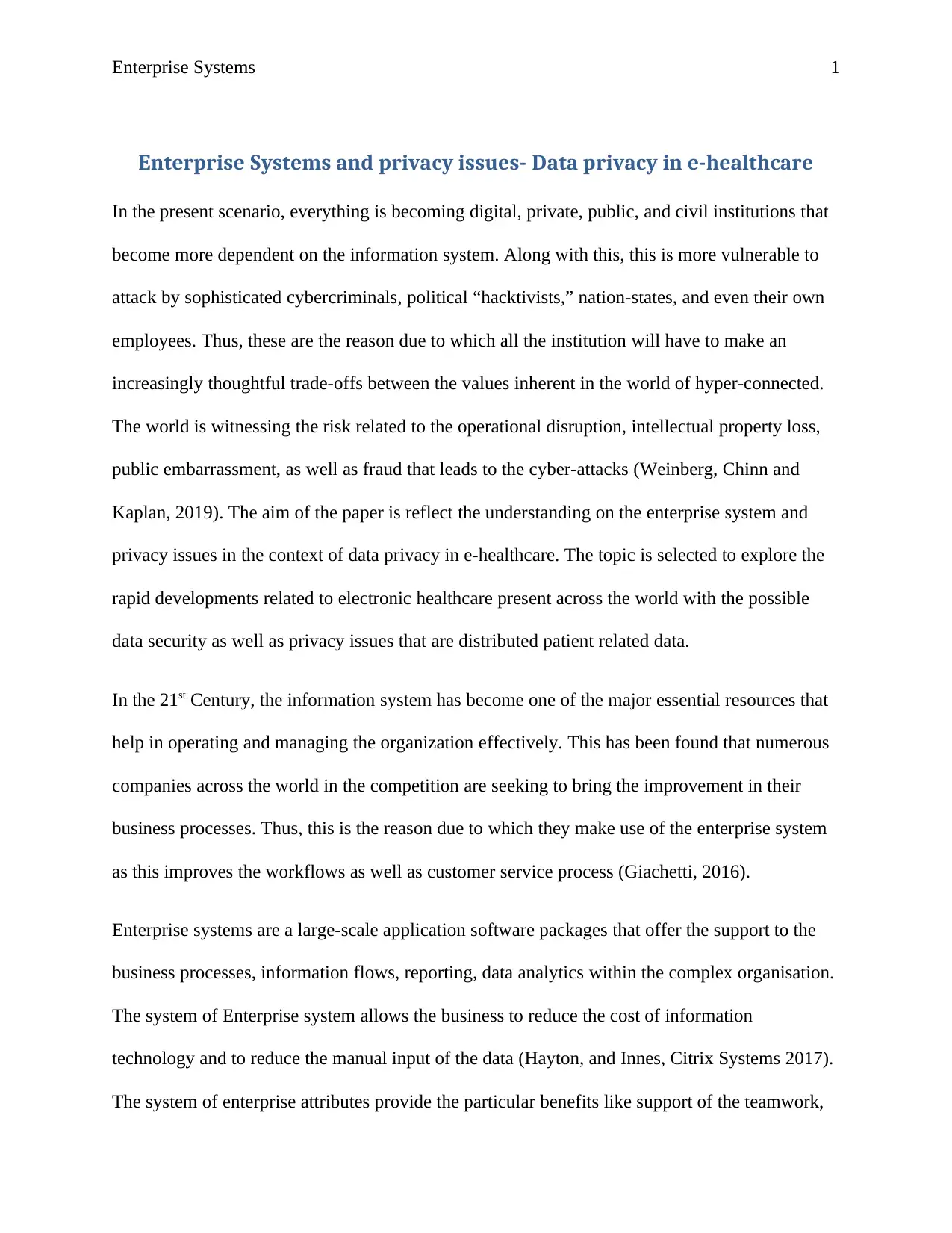
Enterprise Systems 1
Enterprise Systems and privacy issues- Data privacy in e-healthcare
In the present scenario, everything is becoming digital, private, public, and civil institutions that
become more dependent on the information system. Along with this, this is more vulnerable to
attack by sophisticated cybercriminals, political “hacktivists,” nation-states, and even their own
employees. Thus, these are the reason due to which all the institution will have to make an
increasingly thoughtful trade-offs between the values inherent in the world of hyper-connected.
The world is witnessing the risk related to the operational disruption, intellectual property loss,
public embarrassment, as well as fraud that leads to the cyber-attacks (Weinberg, Chinn and
Kaplan, 2019). The aim of the paper is reflect the understanding on the enterprise system and
privacy issues in the context of data privacy in e-healthcare. The topic is selected to explore the
rapid developments related to electronic healthcare present across the world with the possible
data security as well as privacy issues that are distributed patient related data.
In the 21st Century, the information system has become one of the major essential resources that
help in operating and managing the organization effectively. This has been found that numerous
companies across the world in the competition are seeking to bring the improvement in their
business processes. Thus, this is the reason due to which they make use of the enterprise system
as this improves the workflows as well as customer service process (Giachetti, 2016).
Enterprise systems are a large-scale application software packages that offer the support to the
business processes, information flows, reporting, data analytics within the complex organisation.
The system of Enterprise system allows the business to reduce the cost of information
technology and to reduce the manual input of the data (Hayton, and Innes, Citrix Systems 2017).
The system of enterprise attributes provide the particular benefits like support of the teamwork,
Enterprise Systems and privacy issues- Data privacy in e-healthcare
In the present scenario, everything is becoming digital, private, public, and civil institutions that
become more dependent on the information system. Along with this, this is more vulnerable to
attack by sophisticated cybercriminals, political “hacktivists,” nation-states, and even their own
employees. Thus, these are the reason due to which all the institution will have to make an
increasingly thoughtful trade-offs between the values inherent in the world of hyper-connected.
The world is witnessing the risk related to the operational disruption, intellectual property loss,
public embarrassment, as well as fraud that leads to the cyber-attacks (Weinberg, Chinn and
Kaplan, 2019). The aim of the paper is reflect the understanding on the enterprise system and
privacy issues in the context of data privacy in e-healthcare. The topic is selected to explore the
rapid developments related to electronic healthcare present across the world with the possible
data security as well as privacy issues that are distributed patient related data.
In the 21st Century, the information system has become one of the major essential resources that
help in operating and managing the organization effectively. This has been found that numerous
companies across the world in the competition are seeking to bring the improvement in their
business processes. Thus, this is the reason due to which they make use of the enterprise system
as this improves the workflows as well as customer service process (Giachetti, 2016).
Enterprise systems are a large-scale application software packages that offer the support to the
business processes, information flows, reporting, data analytics within the complex organisation.
The system of Enterprise system allows the business to reduce the cost of information
technology and to reduce the manual input of the data (Hayton, and Innes, Citrix Systems 2017).
The system of enterprise attributes provide the particular benefits like support of the teamwork,
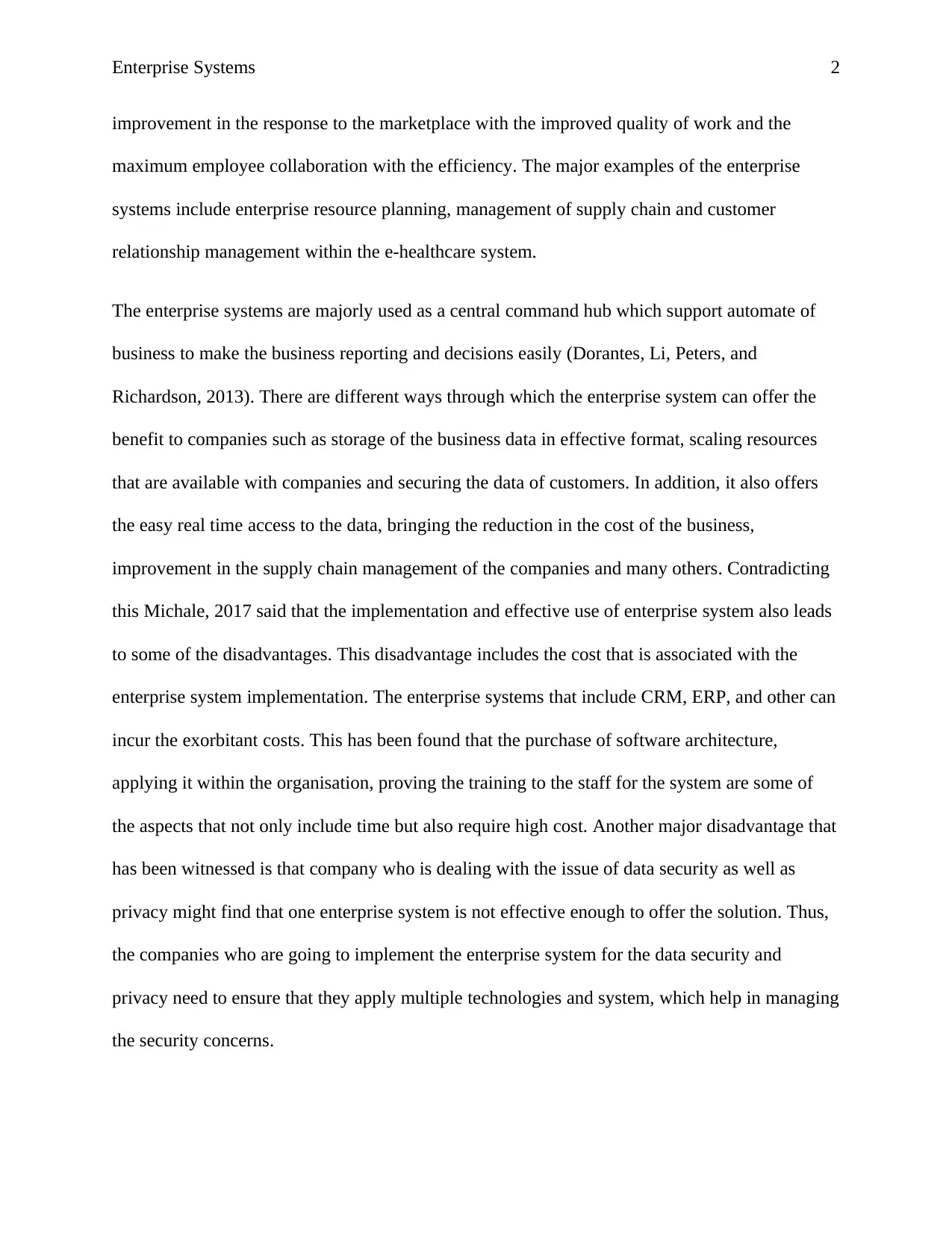
Enterprise Systems 2
improvement in the response to the marketplace with the improved quality of work and the
maximum employee collaboration with the efficiency. The major examples of the enterprise
systems include enterprise resource planning, management of supply chain and customer
relationship management within the e-healthcare system.
The enterprise systems are majorly used as a central command hub which support automate of
business to make the business reporting and decisions easily (Dorantes, Li, Peters, and
Richardson, 2013). There are different ways through which the enterprise system can offer the
benefit to companies such as storage of the business data in effective format, scaling resources
that are available with companies and securing the data of customers. In addition, it also offers
the easy real time access to the data, bringing the reduction in the cost of the business,
improvement in the supply chain management of the companies and many others. Contradicting
this Michale, 2017 said that the implementation and effective use of enterprise system also leads
to some of the disadvantages. This disadvantage includes the cost that is associated with the
enterprise system implementation. The enterprise systems that include CRM, ERP, and other can
incur the exorbitant costs. This has been found that the purchase of software architecture,
applying it within the organisation, proving the training to the staff for the system are some of
the aspects that not only include time but also require high cost. Another major disadvantage that
has been witnessed is that company who is dealing with the issue of data security as well as
privacy might find that one enterprise system is not effective enough to offer the solution. Thus,
the companies who are going to implement the enterprise system for the data security and
privacy need to ensure that they apply multiple technologies and system, which help in managing
the security concerns.
improvement in the response to the marketplace with the improved quality of work and the
maximum employee collaboration with the efficiency. The major examples of the enterprise
systems include enterprise resource planning, management of supply chain and customer
relationship management within the e-healthcare system.
The enterprise systems are majorly used as a central command hub which support automate of
business to make the business reporting and decisions easily (Dorantes, Li, Peters, and
Richardson, 2013). There are different ways through which the enterprise system can offer the
benefit to companies such as storage of the business data in effective format, scaling resources
that are available with companies and securing the data of customers. In addition, it also offers
the easy real time access to the data, bringing the reduction in the cost of the business,
improvement in the supply chain management of the companies and many others. Contradicting
this Michale, 2017 said that the implementation and effective use of enterprise system also leads
to some of the disadvantages. This disadvantage includes the cost that is associated with the
enterprise system implementation. The enterprise systems that include CRM, ERP, and other can
incur the exorbitant costs. This has been found that the purchase of software architecture,
applying it within the organisation, proving the training to the staff for the system are some of
the aspects that not only include time but also require high cost. Another major disadvantage that
has been witnessed is that company who is dealing with the issue of data security as well as
privacy might find that one enterprise system is not effective enough to offer the solution. Thus,
the companies who are going to implement the enterprise system for the data security and
privacy need to ensure that they apply multiple technologies and system, which help in managing
the security concerns.
⊘ This is a preview!⊘
Do you want full access?
Subscribe today to unlock all pages.

Trusted by 1+ million students worldwide
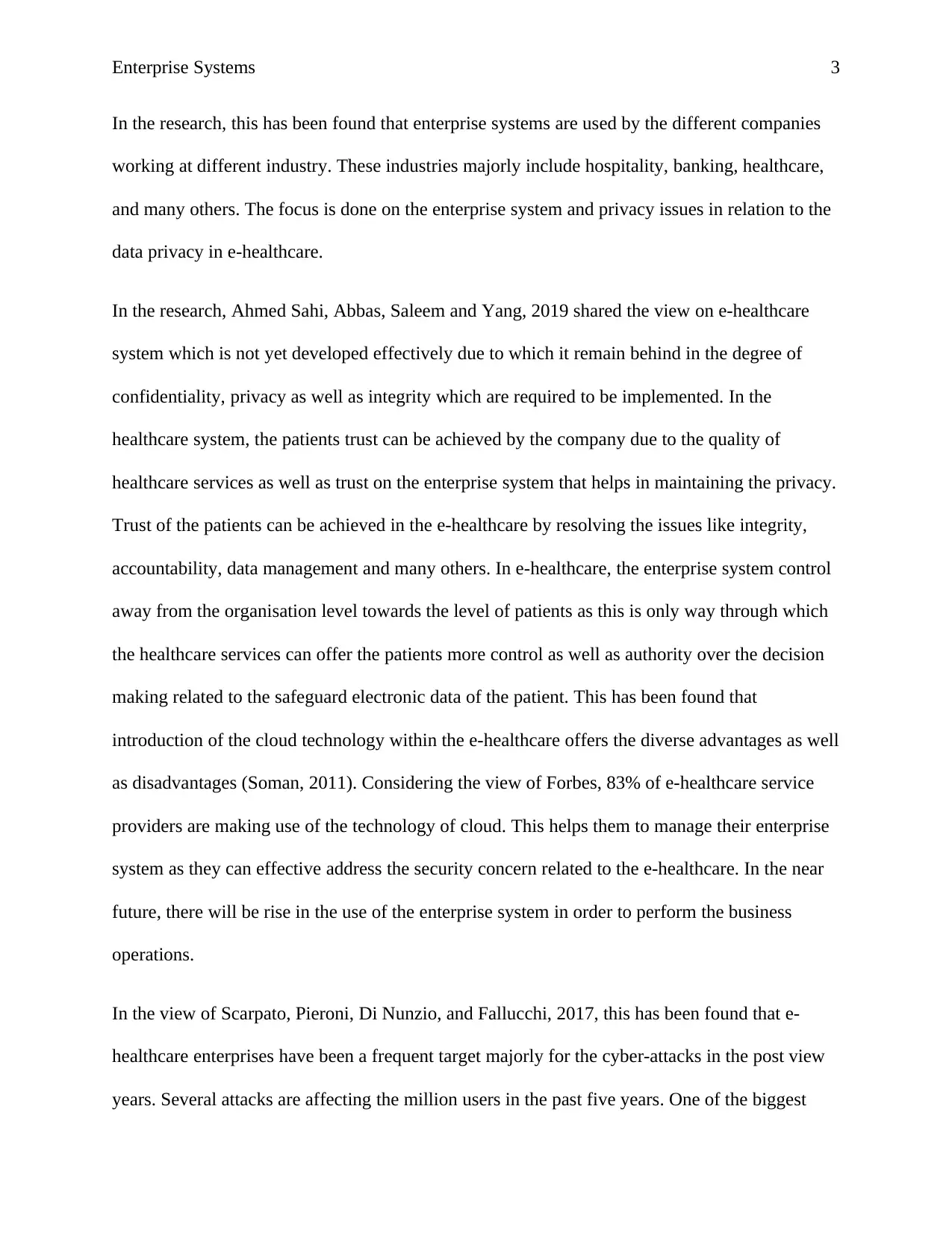
Enterprise Systems 3
In the research, this has been found that enterprise systems are used by the different companies
working at different industry. These industries majorly include hospitality, banking, healthcare,
and many others. The focus is done on the enterprise system and privacy issues in relation to the
data privacy in e-healthcare.
In the research, Ahmed Sahi, Abbas, Saleem and Yang, 2019 shared the view on e-healthcare
system which is not yet developed effectively due to which it remain behind in the degree of
confidentiality, privacy as well as integrity which are required to be implemented. In the
healthcare system, the patients trust can be achieved by the company due to the quality of
healthcare services as well as trust on the enterprise system that helps in maintaining the privacy.
Trust of the patients can be achieved in the e-healthcare by resolving the issues like integrity,
accountability, data management and many others. In e-healthcare, the enterprise system control
away from the organisation level towards the level of patients as this is only way through which
the healthcare services can offer the patients more control as well as authority over the decision
making related to the safeguard electronic data of the patient. This has been found that
introduction of the cloud technology within the e-healthcare offers the diverse advantages as well
as disadvantages (Soman, 2011). Considering the view of Forbes, 83% of e-healthcare service
providers are making use of the technology of cloud. This helps them to manage their enterprise
system as they can effective address the security concern related to the e-healthcare. In the near
future, there will be rise in the use of the enterprise system in order to perform the business
operations.
In the view of Scarpato, Pieroni, Di Nunzio, and Fallucchi, 2017, this has been found that e-
healthcare enterprises have been a frequent target majorly for the cyber-attacks in the post view
years. Several attacks are affecting the million users in the past five years. One of the biggest
In the research, this has been found that enterprise systems are used by the different companies
working at different industry. These industries majorly include hospitality, banking, healthcare,
and many others. The focus is done on the enterprise system and privacy issues in relation to the
data privacy in e-healthcare.
In the research, Ahmed Sahi, Abbas, Saleem and Yang, 2019 shared the view on e-healthcare
system which is not yet developed effectively due to which it remain behind in the degree of
confidentiality, privacy as well as integrity which are required to be implemented. In the
healthcare system, the patients trust can be achieved by the company due to the quality of
healthcare services as well as trust on the enterprise system that helps in maintaining the privacy.
Trust of the patients can be achieved in the e-healthcare by resolving the issues like integrity,
accountability, data management and many others. In e-healthcare, the enterprise system control
away from the organisation level towards the level of patients as this is only way through which
the healthcare services can offer the patients more control as well as authority over the decision
making related to the safeguard electronic data of the patient. This has been found that
introduction of the cloud technology within the e-healthcare offers the diverse advantages as well
as disadvantages (Soman, 2011). Considering the view of Forbes, 83% of e-healthcare service
providers are making use of the technology of cloud. This helps them to manage their enterprise
system as they can effective address the security concern related to the e-healthcare. In the near
future, there will be rise in the use of the enterprise system in order to perform the business
operations.
In the view of Scarpato, Pieroni, Di Nunzio, and Fallucchi, 2017, this has been found that e-
healthcare enterprises have been a frequent target majorly for the cyber-attacks in the post view
years. Several attacks are affecting the million users in the past five years. One of the biggest
Paraphrase This Document
Need a fresh take? Get an instant paraphrase of this document with our AI Paraphraser
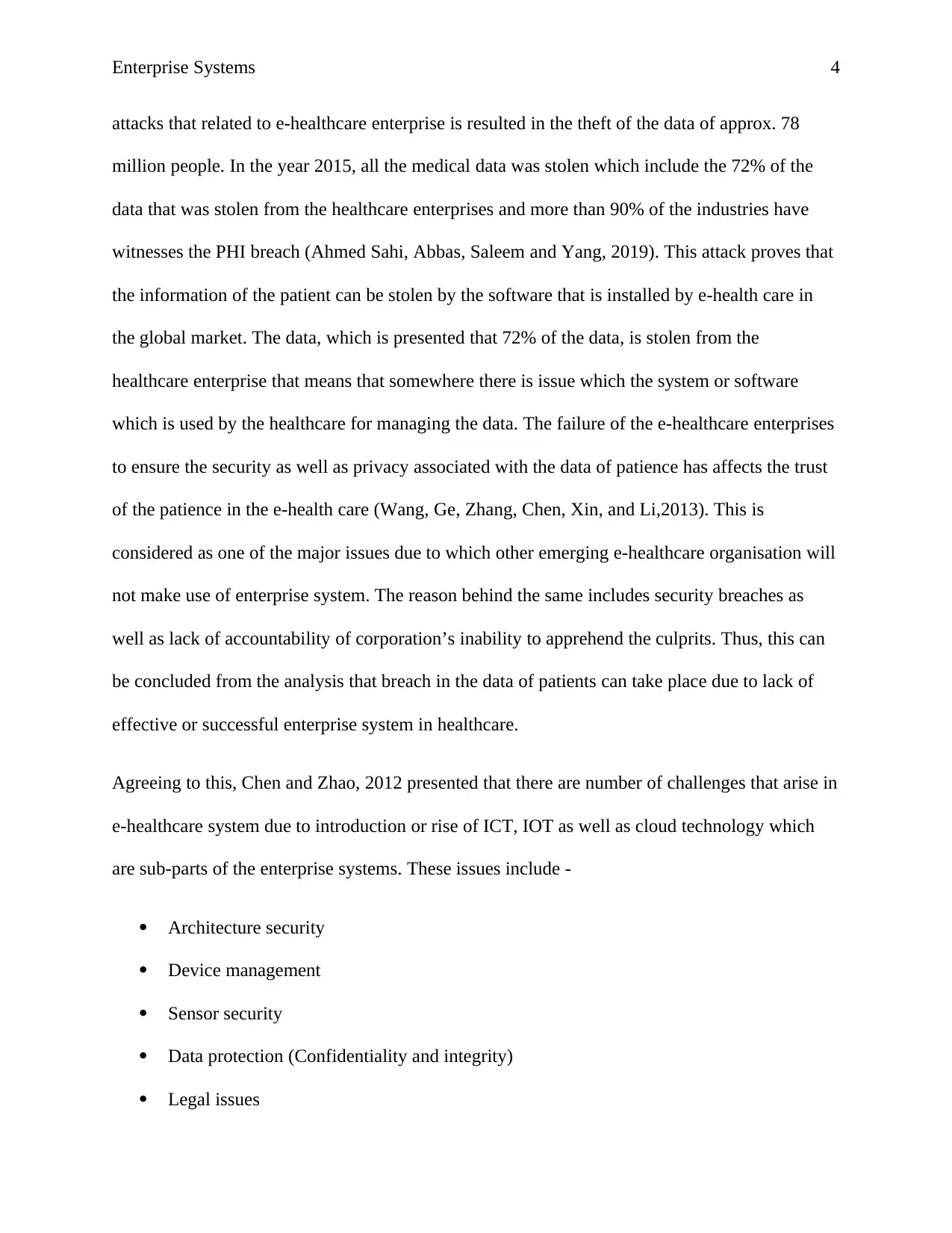
Enterprise Systems 4
attacks that related to e-healthcare enterprise is resulted in the theft of the data of approx. 78
million people. In the year 2015, all the medical data was stolen which include the 72% of the
data that was stolen from the healthcare enterprises and more than 90% of the industries have
witnesses the PHI breach (Ahmed Sahi, Abbas, Saleem and Yang, 2019). This attack proves that
the information of the patient can be stolen by the software that is installed by e-health care in
the global market. The data, which is presented that 72% of the data, is stolen from the
healthcare enterprise that means that somewhere there is issue which the system or software
which is used by the healthcare for managing the data. The failure of the e-healthcare enterprises
to ensure the security as well as privacy associated with the data of patience has affects the trust
of the patience in the e-health care (Wang, Ge, Zhang, Chen, Xin, and Li,2013). This is
considered as one of the major issues due to which other emerging e-healthcare organisation will
not make use of enterprise system. The reason behind the same includes security breaches as
well as lack of accountability of corporation’s inability to apprehend the culprits. Thus, this can
be concluded from the analysis that breach in the data of patients can take place due to lack of
effective or successful enterprise system in healthcare.
Agreeing to this, Chen and Zhao, 2012 presented that there are number of challenges that arise in
e-healthcare system due to introduction or rise of ICT, IOT as well as cloud technology which
are sub-parts of the enterprise systems. These issues include -
Architecture security
Device management
Sensor security
Data protection (Confidentiality and integrity)
Legal issues
attacks that related to e-healthcare enterprise is resulted in the theft of the data of approx. 78
million people. In the year 2015, all the medical data was stolen which include the 72% of the
data that was stolen from the healthcare enterprises and more than 90% of the industries have
witnesses the PHI breach (Ahmed Sahi, Abbas, Saleem and Yang, 2019). This attack proves that
the information of the patient can be stolen by the software that is installed by e-health care in
the global market. The data, which is presented that 72% of the data, is stolen from the
healthcare enterprise that means that somewhere there is issue which the system or software
which is used by the healthcare for managing the data. The failure of the e-healthcare enterprises
to ensure the security as well as privacy associated with the data of patience has affects the trust
of the patience in the e-health care (Wang, Ge, Zhang, Chen, Xin, and Li,2013). This is
considered as one of the major issues due to which other emerging e-healthcare organisation will
not make use of enterprise system. The reason behind the same includes security breaches as
well as lack of accountability of corporation’s inability to apprehend the culprits. Thus, this can
be concluded from the analysis that breach in the data of patients can take place due to lack of
effective or successful enterprise system in healthcare.
Agreeing to this, Chen and Zhao, 2012 presented that there are number of challenges that arise in
e-healthcare system due to introduction or rise of ICT, IOT as well as cloud technology which
are sub-parts of the enterprise systems. These issues include -
Architecture security
Device management
Sensor security
Data protection (Confidentiality and integrity)
Legal issues
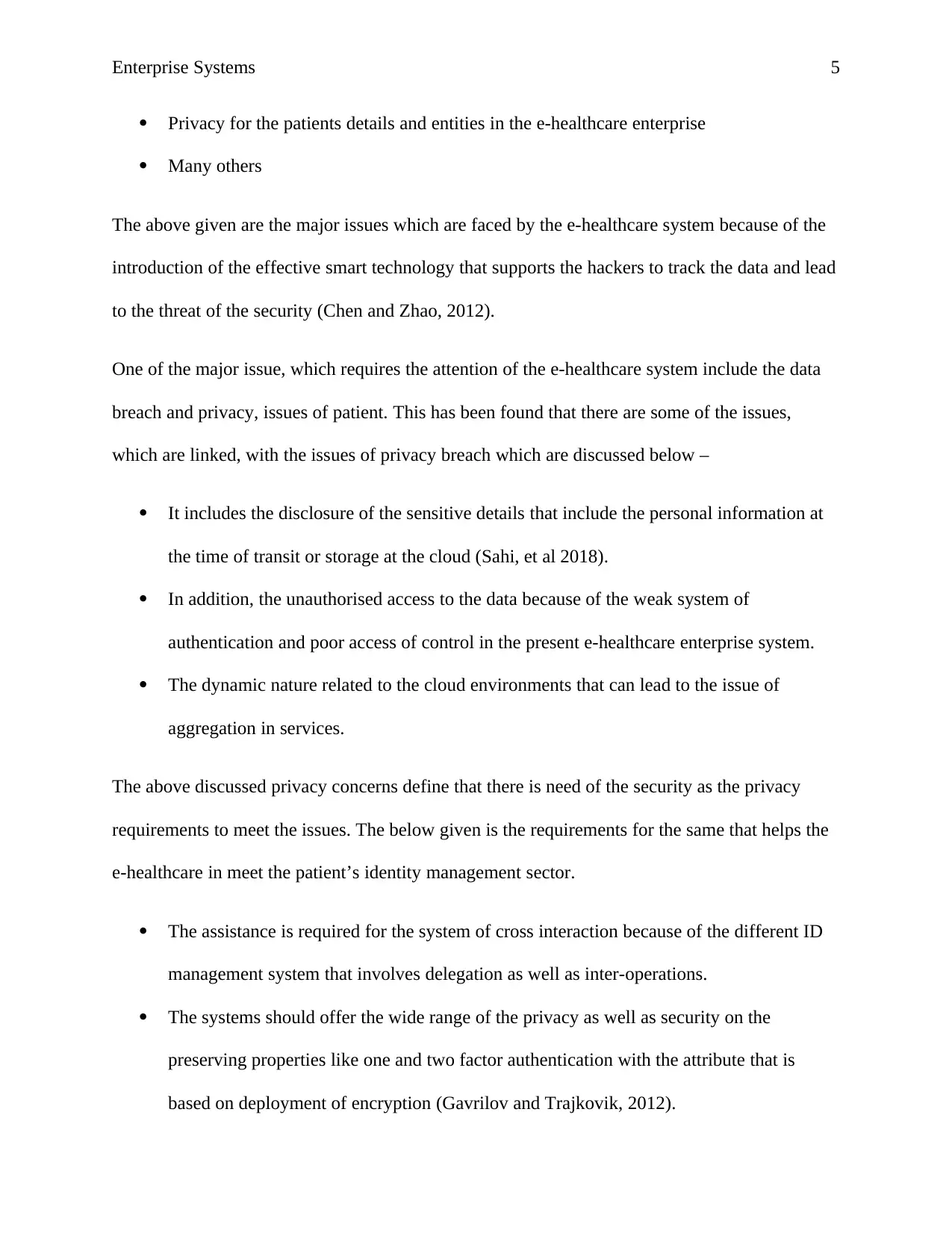
Enterprise Systems 5
Privacy for the patients details and entities in the e-healthcare enterprise
Many others
The above given are the major issues which are faced by the e-healthcare system because of the
introduction of the effective smart technology that supports the hackers to track the data and lead
to the threat of the security (Chen and Zhao, 2012).
One of the major issue, which requires the attention of the e-healthcare system include the data
breach and privacy, issues of patient. This has been found that there are some of the issues,
which are linked, with the issues of privacy breach which are discussed below –
It includes the disclosure of the sensitive details that include the personal information at
the time of transit or storage at the cloud (Sahi, et al 2018).
In addition, the unauthorised access to the data because of the weak system of
authentication and poor access of control in the present e-healthcare enterprise system.
The dynamic nature related to the cloud environments that can lead to the issue of
aggregation in services.
The above discussed privacy concerns define that there is need of the security as the privacy
requirements to meet the issues. The below given is the requirements for the same that helps the
e-healthcare in meet the patient’s identity management sector.
The assistance is required for the system of cross interaction because of the different ID
management system that involves delegation as well as inter-operations.
The systems should offer the wide range of the privacy as well as security on the
preserving properties like one and two factor authentication with the attribute that is
based on deployment of encryption (Gavrilov and Trajkovik, 2012).
Privacy for the patients details and entities in the e-healthcare enterprise
Many others
The above given are the major issues which are faced by the e-healthcare system because of the
introduction of the effective smart technology that supports the hackers to track the data and lead
to the threat of the security (Chen and Zhao, 2012).
One of the major issue, which requires the attention of the e-healthcare system include the data
breach and privacy, issues of patient. This has been found that there are some of the issues,
which are linked, with the issues of privacy breach which are discussed below –
It includes the disclosure of the sensitive details that include the personal information at
the time of transit or storage at the cloud (Sahi, et al 2018).
In addition, the unauthorised access to the data because of the weak system of
authentication and poor access of control in the present e-healthcare enterprise system.
The dynamic nature related to the cloud environments that can lead to the issue of
aggregation in services.
The above discussed privacy concerns define that there is need of the security as the privacy
requirements to meet the issues. The below given is the requirements for the same that helps the
e-healthcare in meet the patient’s identity management sector.
The assistance is required for the system of cross interaction because of the different ID
management system that involves delegation as well as inter-operations.
The systems should offer the wide range of the privacy as well as security on the
preserving properties like one and two factor authentication with the attribute that is
based on deployment of encryption (Gavrilov and Trajkovik, 2012).
⊘ This is a preview!⊘
Do you want full access?
Subscribe today to unlock all pages.

Trusted by 1+ million students worldwide
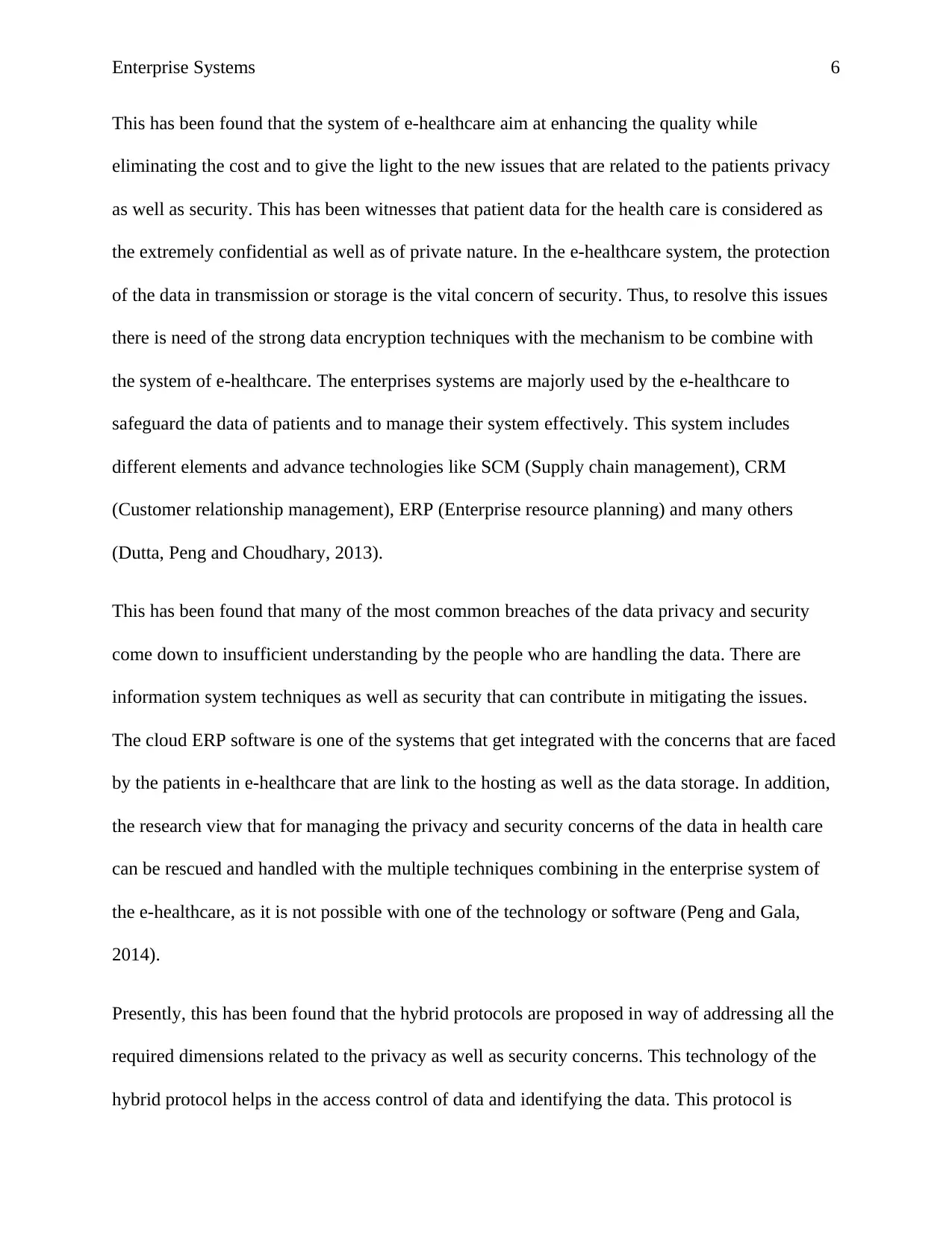
Enterprise Systems 6
This has been found that the system of e-healthcare aim at enhancing the quality while
eliminating the cost and to give the light to the new issues that are related to the patients privacy
as well as security. This has been witnesses that patient data for the health care is considered as
the extremely confidential as well as of private nature. In the e-healthcare system, the protection
of the data in transmission or storage is the vital concern of security. Thus, to resolve this issues
there is need of the strong data encryption techniques with the mechanism to be combine with
the system of e-healthcare. The enterprises systems are majorly used by the e-healthcare to
safeguard the data of patients and to manage their system effectively. This system includes
different elements and advance technologies like SCM (Supply chain management), CRM
(Customer relationship management), ERP (Enterprise resource planning) and many others
(Dutta, Peng and Choudhary, 2013).
This has been found that many of the most common breaches of the data privacy and security
come down to insufficient understanding by the people who are handling the data. There are
information system techniques as well as security that can contribute in mitigating the issues.
The cloud ERP software is one of the systems that get integrated with the concerns that are faced
by the patients in e-healthcare that are link to the hosting as well as the data storage. In addition,
the research view that for managing the privacy and security concerns of the data in health care
can be rescued and handled with the multiple techniques combining in the enterprise system of
the e-healthcare, as it is not possible with one of the technology or software (Peng and Gala,
2014).
Presently, this has been found that the hybrid protocols are proposed in way of addressing all the
required dimensions related to the privacy as well as security concerns. This technology of the
hybrid protocol helps in the access control of data and identifying the data. This protocol is
This has been found that the system of e-healthcare aim at enhancing the quality while
eliminating the cost and to give the light to the new issues that are related to the patients privacy
as well as security. This has been witnesses that patient data for the health care is considered as
the extremely confidential as well as of private nature. In the e-healthcare system, the protection
of the data in transmission or storage is the vital concern of security. Thus, to resolve this issues
there is need of the strong data encryption techniques with the mechanism to be combine with
the system of e-healthcare. The enterprises systems are majorly used by the e-healthcare to
safeguard the data of patients and to manage their system effectively. This system includes
different elements and advance technologies like SCM (Supply chain management), CRM
(Customer relationship management), ERP (Enterprise resource planning) and many others
(Dutta, Peng and Choudhary, 2013).
This has been found that many of the most common breaches of the data privacy and security
come down to insufficient understanding by the people who are handling the data. There are
information system techniques as well as security that can contribute in mitigating the issues.
The cloud ERP software is one of the systems that get integrated with the concerns that are faced
by the patients in e-healthcare that are link to the hosting as well as the data storage. In addition,
the research view that for managing the privacy and security concerns of the data in health care
can be rescued and handled with the multiple techniques combining in the enterprise system of
the e-healthcare, as it is not possible with one of the technology or software (Peng and Gala,
2014).
Presently, this has been found that the hybrid protocols are proposed in way of addressing all the
required dimensions related to the privacy as well as security concerns. This technology of the
hybrid protocol helps in the access control of data and identifying the data. This protocol is
Paraphrase This Document
Need a fresh take? Get an instant paraphrase of this document with our AI Paraphraser
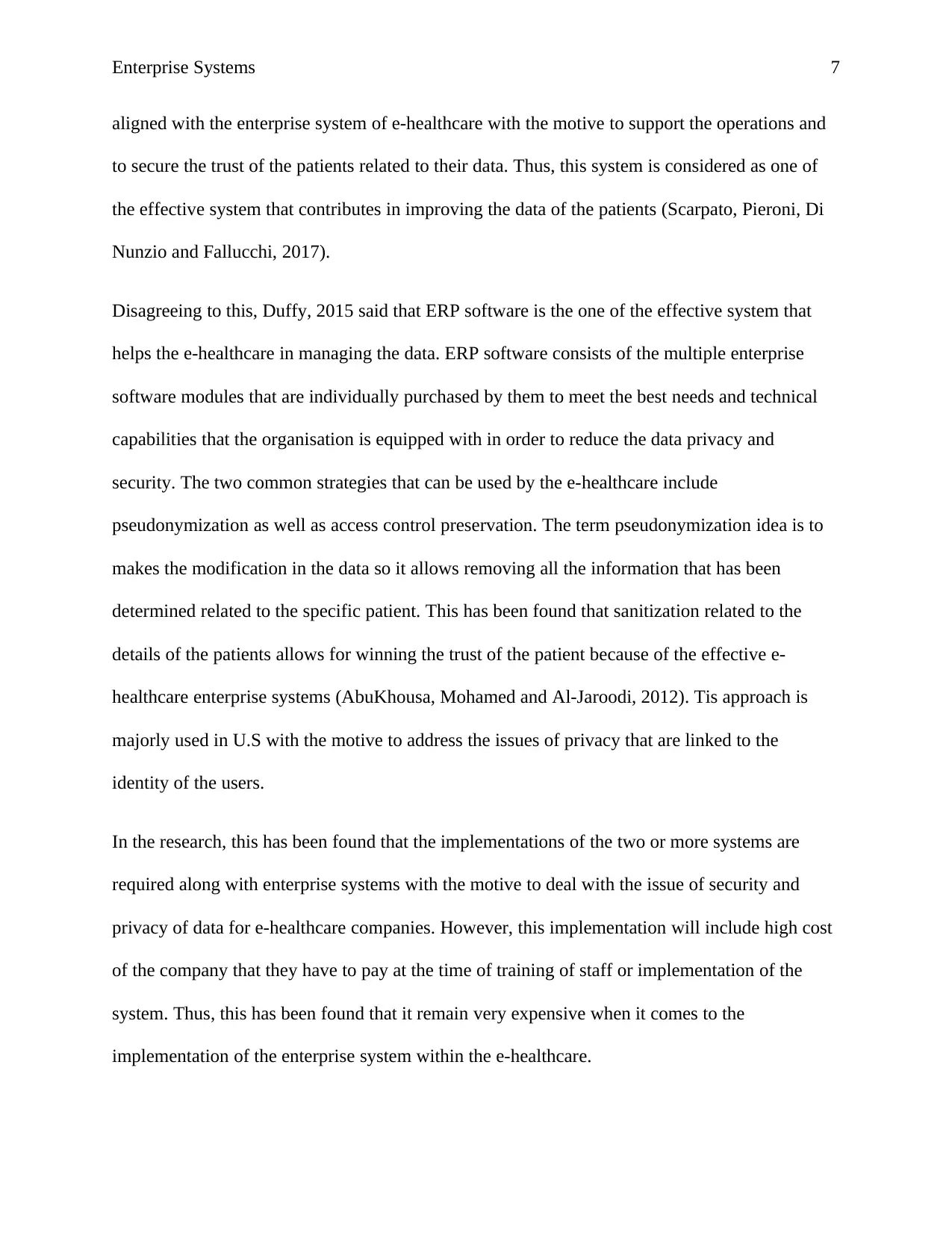
Enterprise Systems 7
aligned with the enterprise system of e-healthcare with the motive to support the operations and
to secure the trust of the patients related to their data. Thus, this system is considered as one of
the effective system that contributes in improving the data of the patients (Scarpato, Pieroni, Di
Nunzio and Fallucchi, 2017).
Disagreeing to this, Duffy, 2015 said that ERP software is the one of the effective system that
helps the e-healthcare in managing the data. ERP software consists of the multiple enterprise
software modules that are individually purchased by them to meet the best needs and technical
capabilities that the organisation is equipped with in order to reduce the data privacy and
security. The two common strategies that can be used by the e-healthcare include
pseudonymization as well as access control preservation. The term pseudonymization idea is to
makes the modification in the data so it allows removing all the information that has been
determined related to the specific patient. This has been found that sanitization related to the
details of the patients allows for winning the trust of the patient because of the effective e-
healthcare enterprise systems (AbuKhousa, Mohamed and Al-Jaroodi, 2012). Tis approach is
majorly used in U.S with the motive to address the issues of privacy that are linked to the
identity of the users.
In the research, this has been found that the implementations of the two or more systems are
required along with enterprise systems with the motive to deal with the issue of security and
privacy of data for e-healthcare companies. However, this implementation will include high cost
of the company that they have to pay at the time of training of staff or implementation of the
system. Thus, this has been found that it remain very expensive when it comes to the
implementation of the enterprise system within the e-healthcare.
aligned with the enterprise system of e-healthcare with the motive to support the operations and
to secure the trust of the patients related to their data. Thus, this system is considered as one of
the effective system that contributes in improving the data of the patients (Scarpato, Pieroni, Di
Nunzio and Fallucchi, 2017).
Disagreeing to this, Duffy, 2015 said that ERP software is the one of the effective system that
helps the e-healthcare in managing the data. ERP software consists of the multiple enterprise
software modules that are individually purchased by them to meet the best needs and technical
capabilities that the organisation is equipped with in order to reduce the data privacy and
security. The two common strategies that can be used by the e-healthcare include
pseudonymization as well as access control preservation. The term pseudonymization idea is to
makes the modification in the data so it allows removing all the information that has been
determined related to the specific patient. This has been found that sanitization related to the
details of the patients allows for winning the trust of the patient because of the effective e-
healthcare enterprise systems (AbuKhousa, Mohamed and Al-Jaroodi, 2012). Tis approach is
majorly used in U.S with the motive to address the issues of privacy that are linked to the
identity of the users.
In the research, this has been found that the implementations of the two or more systems are
required along with enterprise systems with the motive to deal with the issue of security and
privacy of data for e-healthcare companies. However, this implementation will include high cost
of the company that they have to pay at the time of training of staff or implementation of the
system. Thus, this has been found that it remain very expensive when it comes to the
implementation of the enterprise system within the e-healthcare.
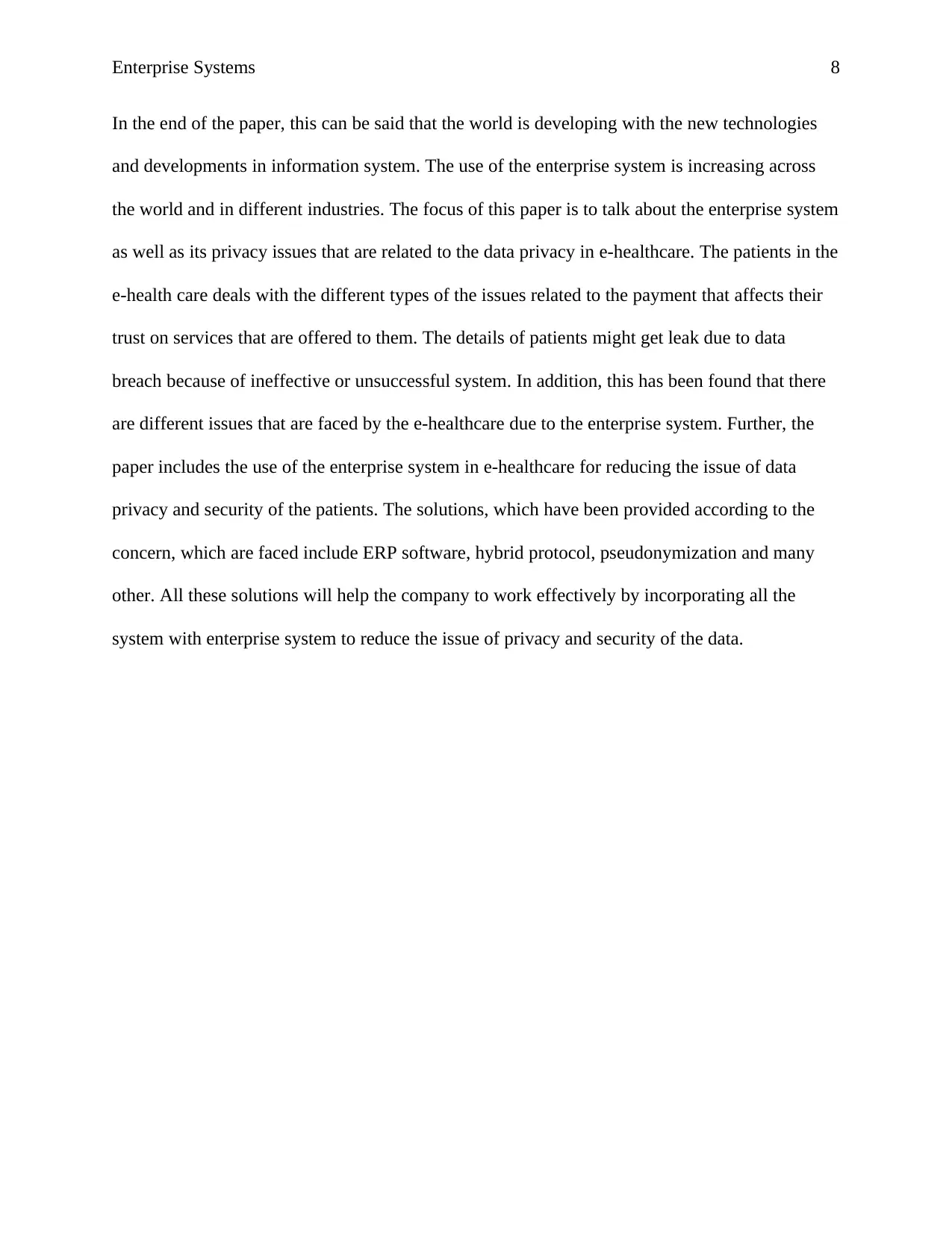
Enterprise Systems 8
In the end of the paper, this can be said that the world is developing with the new technologies
and developments in information system. The use of the enterprise system is increasing across
the world and in different industries. The focus of this paper is to talk about the enterprise system
as well as its privacy issues that are related to the data privacy in e-healthcare. The patients in the
e-health care deals with the different types of the issues related to the payment that affects their
trust on services that are offered to them. The details of patients might get leak due to data
breach because of ineffective or unsuccessful system. In addition, this has been found that there
are different issues that are faced by the e-healthcare due to the enterprise system. Further, the
paper includes the use of the enterprise system in e-healthcare for reducing the issue of data
privacy and security of the patients. The solutions, which have been provided according to the
concern, which are faced include ERP software, hybrid protocol, pseudonymization and many
other. All these solutions will help the company to work effectively by incorporating all the
system with enterprise system to reduce the issue of privacy and security of the data.
In the end of the paper, this can be said that the world is developing with the new technologies
and developments in information system. The use of the enterprise system is increasing across
the world and in different industries. The focus of this paper is to talk about the enterprise system
as well as its privacy issues that are related to the data privacy in e-healthcare. The patients in the
e-health care deals with the different types of the issues related to the payment that affects their
trust on services that are offered to them. The details of patients might get leak due to data
breach because of ineffective or unsuccessful system. In addition, this has been found that there
are different issues that are faced by the e-healthcare due to the enterprise system. Further, the
paper includes the use of the enterprise system in e-healthcare for reducing the issue of data
privacy and security of the patients. The solutions, which have been provided according to the
concern, which are faced include ERP software, hybrid protocol, pseudonymization and many
other. All these solutions will help the company to work effectively by incorporating all the
system with enterprise system to reduce the issue of privacy and security of the data.
⊘ This is a preview!⊘
Do you want full access?
Subscribe today to unlock all pages.

Trusted by 1+ million students worldwide
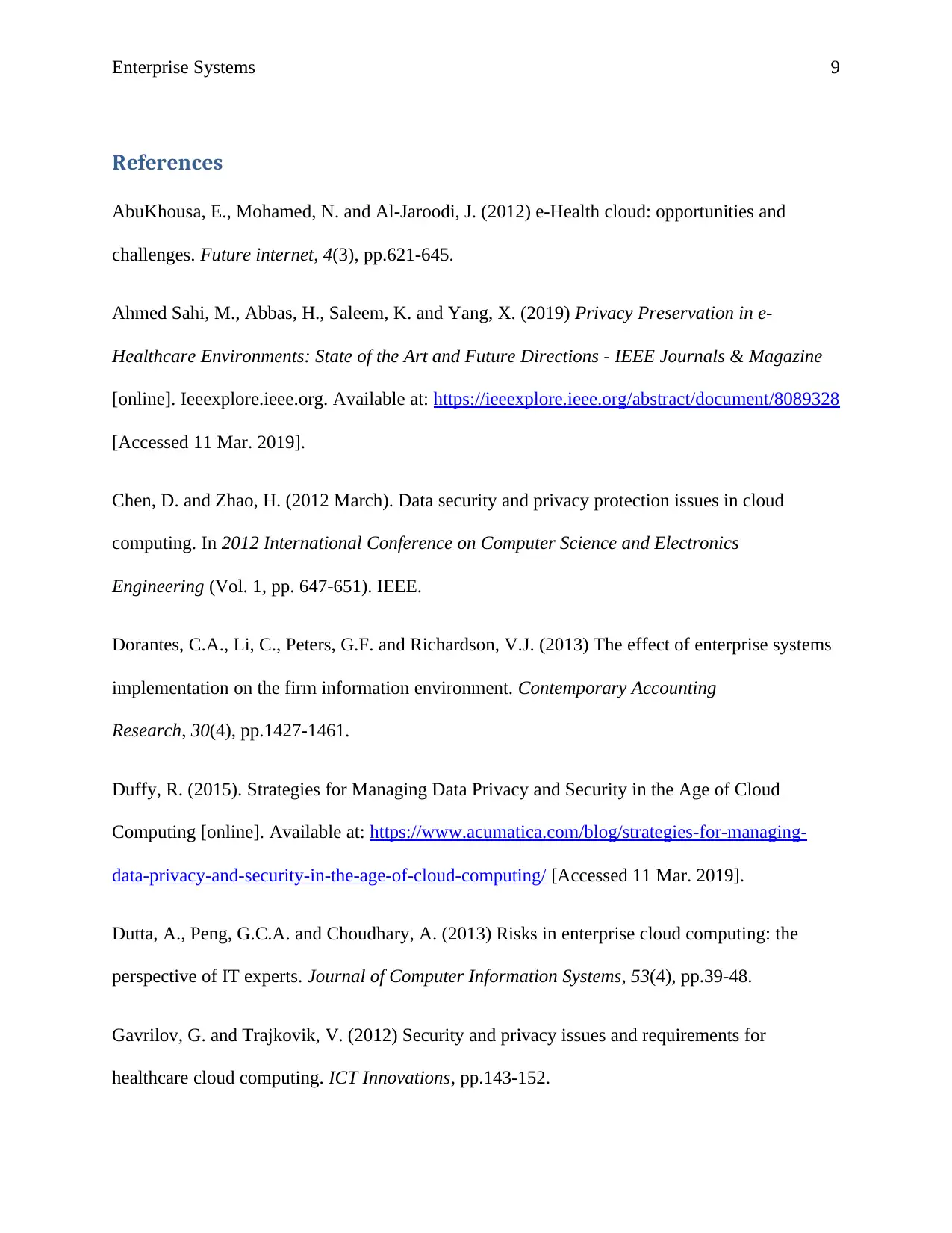
Enterprise Systems 9
References
AbuKhousa, E., Mohamed, N. and Al-Jaroodi, J. (2012) e-Health cloud: opportunities and
challenges. Future internet, 4(3), pp.621-645.
Ahmed Sahi, M., Abbas, H., Saleem, K. and Yang, X. (2019) Privacy Preservation in e-
Healthcare Environments: State of the Art and Future Directions - IEEE Journals & Magazine
[online]. Ieeexplore.ieee.org. Available at: https://ieeexplore.ieee.org/abstract/document/8089328
[Accessed 11 Mar. 2019].
Chen, D. and Zhao, H. (2012 March). Data security and privacy protection issues in cloud
computing. In 2012 International Conference on Computer Science and Electronics
Engineering (Vol. 1, pp. 647-651). IEEE.
Dorantes, C.A., Li, C., Peters, G.F. and Richardson, V.J. (2013) The effect of enterprise systems
implementation on the firm information environment. Contemporary Accounting
Research, 30(4), pp.1427-1461.
Duffy, R. (2015). Strategies for Managing Data Privacy and Security in the Age of Cloud
Computing [online]. Available at: https://www.acumatica.com/blog/strategies-for-managing-
data-privacy-and-security-in-the-age-of-cloud-computing/ [Accessed 11 Mar. 2019].
Dutta, A., Peng, G.C.A. and Choudhary, A. (2013) Risks in enterprise cloud computing: the
perspective of IT experts. Journal of Computer Information Systems, 53(4), pp.39-48.
Gavrilov, G. and Trajkovik, V. (2012) Security and privacy issues and requirements for
healthcare cloud computing. ICT Innovations, pp.143-152.
References
AbuKhousa, E., Mohamed, N. and Al-Jaroodi, J. (2012) e-Health cloud: opportunities and
challenges. Future internet, 4(3), pp.621-645.
Ahmed Sahi, M., Abbas, H., Saleem, K. and Yang, X. (2019) Privacy Preservation in e-
Healthcare Environments: State of the Art and Future Directions - IEEE Journals & Magazine
[online]. Ieeexplore.ieee.org. Available at: https://ieeexplore.ieee.org/abstract/document/8089328
[Accessed 11 Mar. 2019].
Chen, D. and Zhao, H. (2012 March). Data security and privacy protection issues in cloud
computing. In 2012 International Conference on Computer Science and Electronics
Engineering (Vol. 1, pp. 647-651). IEEE.
Dorantes, C.A., Li, C., Peters, G.F. and Richardson, V.J. (2013) The effect of enterprise systems
implementation on the firm information environment. Contemporary Accounting
Research, 30(4), pp.1427-1461.
Duffy, R. (2015). Strategies for Managing Data Privacy and Security in the Age of Cloud
Computing [online]. Available at: https://www.acumatica.com/blog/strategies-for-managing-
data-privacy-and-security-in-the-age-of-cloud-computing/ [Accessed 11 Mar. 2019].
Dutta, A., Peng, G.C.A. and Choudhary, A. (2013) Risks in enterprise cloud computing: the
perspective of IT experts. Journal of Computer Information Systems, 53(4), pp.39-48.
Gavrilov, G. and Trajkovik, V. (2012) Security and privacy issues and requirements for
healthcare cloud computing. ICT Innovations, pp.143-152.
Paraphrase This Document
Need a fresh take? Get an instant paraphrase of this document with our AI Paraphraser
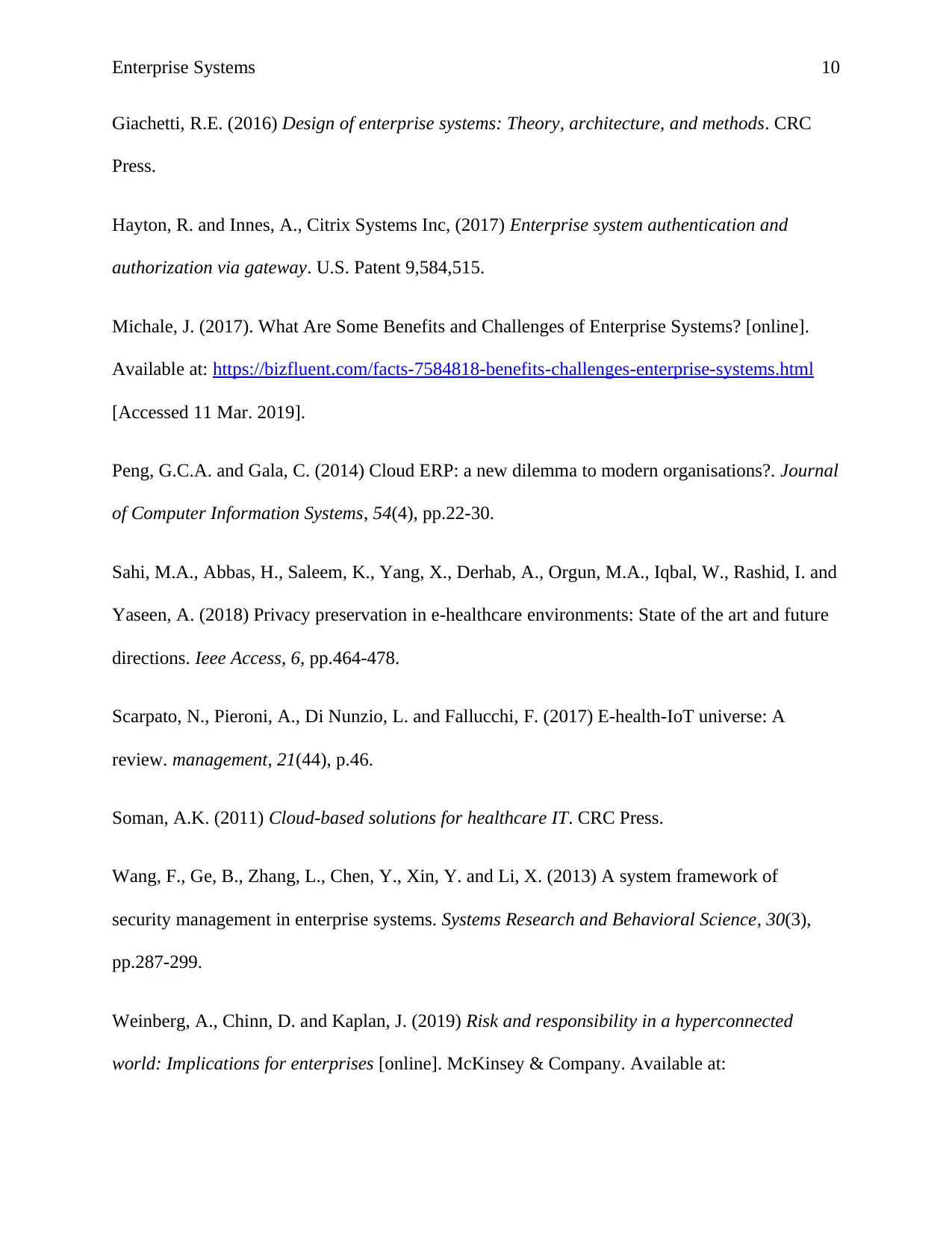
Enterprise Systems 10
Giachetti, R.E. (2016) Design of enterprise systems: Theory, architecture, and methods. CRC
Press.
Hayton, R. and Innes, A., Citrix Systems Inc, (2017) Enterprise system authentication and
authorization via gateway. U.S. Patent 9,584,515.
Michale, J. (2017). What Are Some Benefits and Challenges of Enterprise Systems? [online].
Available at: https://bizfluent.com/facts-7584818-benefits-challenges-enterprise-systems.html
[Accessed 11 Mar. 2019].
Peng, G.C.A. and Gala, C. (2014) Cloud ERP: a new dilemma to modern organisations?. Journal
of Computer Information Systems, 54(4), pp.22-30.
Sahi, M.A., Abbas, H., Saleem, K., Yang, X., Derhab, A., Orgun, M.A., Iqbal, W., Rashid, I. and
Yaseen, A. (2018) Privacy preservation in e-healthcare environments: State of the art and future
directions. Ieee Access, 6, pp.464-478.
Scarpato, N., Pieroni, A., Di Nunzio, L. and Fallucchi, F. (2017) E-health-IoT universe: A
review. management, 21(44), p.46.
Soman, A.K. (2011) Cloud-based solutions for healthcare IT. CRC Press.
Wang, F., Ge, B., Zhang, L., Chen, Y., Xin, Y. and Li, X. (2013) A system framework of
security management in enterprise systems. Systems Research and Behavioral Science, 30(3),
pp.287-299.
Weinberg, A., Chinn, D. and Kaplan, J. (2019) Risk and responsibility in a hyperconnected
world: Implications for enterprises [online]. McKinsey & Company. Available at:
Giachetti, R.E. (2016) Design of enterprise systems: Theory, architecture, and methods. CRC
Press.
Hayton, R. and Innes, A., Citrix Systems Inc, (2017) Enterprise system authentication and
authorization via gateway. U.S. Patent 9,584,515.
Michale, J. (2017). What Are Some Benefits and Challenges of Enterprise Systems? [online].
Available at: https://bizfluent.com/facts-7584818-benefits-challenges-enterprise-systems.html
[Accessed 11 Mar. 2019].
Peng, G.C.A. and Gala, C. (2014) Cloud ERP: a new dilemma to modern organisations?. Journal
of Computer Information Systems, 54(4), pp.22-30.
Sahi, M.A., Abbas, H., Saleem, K., Yang, X., Derhab, A., Orgun, M.A., Iqbal, W., Rashid, I. and
Yaseen, A. (2018) Privacy preservation in e-healthcare environments: State of the art and future
directions. Ieee Access, 6, pp.464-478.
Scarpato, N., Pieroni, A., Di Nunzio, L. and Fallucchi, F. (2017) E-health-IoT universe: A
review. management, 21(44), p.46.
Soman, A.K. (2011) Cloud-based solutions for healthcare IT. CRC Press.
Wang, F., Ge, B., Zhang, L., Chen, Y., Xin, Y. and Li, X. (2013) A system framework of
security management in enterprise systems. Systems Research and Behavioral Science, 30(3),
pp.287-299.
Weinberg, A., Chinn, D. and Kaplan, J. (2019) Risk and responsibility in a hyperconnected
world: Implications for enterprises [online]. McKinsey & Company. Available at:

Enterprise Systems 11
https://www.mckinsey.com/business-functions/digital-mckinsey/our-insights/risk-and-
responsibility-in-a-hyperconnected-world-implications-for-enterprises [Accessed 10 Mar. 2019].
https://www.mckinsey.com/business-functions/digital-mckinsey/our-insights/risk-and-
responsibility-in-a-hyperconnected-world-implications-for-enterprises [Accessed 10 Mar. 2019].
⊘ This is a preview!⊘
Do you want full access?
Subscribe today to unlock all pages.

Trusted by 1+ million students worldwide
1 out of 12
Related Documents
Your All-in-One AI-Powered Toolkit for Academic Success.
+13062052269
info@desklib.com
Available 24*7 on WhatsApp / Email
![[object Object]](/_next/static/media/star-bottom.7253800d.svg)
Unlock your academic potential
Copyright © 2020–2025 A2Z Services. All Rights Reserved. Developed and managed by ZUCOL.





